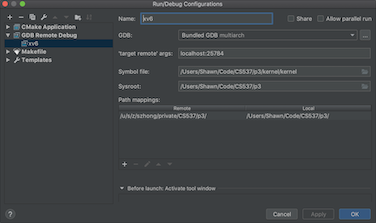

- Clion remote debug install#
- Clion remote debug code#
- Clion remote debug password#
- Clion remote debug download#
- Clion remote debug windows#
Note, that we already have some plans about UI improvements: CPP-7011, CPP-7050. Please, check the new functionality in case you are interested in remote debug, and provide the feedback to us in the comment section below or in our tracker. Another problem could happen from time to time if you have another target configured in the ‘Before Run’ section of the configuration ( CPP-7171). Then select this debugger in the remote GDB configuration.īe aware, that in case you set this debugger to be used globally in the IDE (in Build, Execution, Deployment | Toolchains settings) local debug on macOS won’t work, so we don’t recommend you doing so.īesides note, that in case you have sources with symlinks on your host, to make remote debug work open project in CLion using the canonical paths ( CPP-7052). configure -target=x86_64-linux-gnu -with-python -prefix= Get the binutils-gdb sources from the Git repository, switch branch to gdb-7.11.1-release and build like this: In case you’d like to debug Linux target from macOS host, you have to use GDB version compiled with -target=x86_64-linux-gnu flag. You’ll be able to view variables, evaluate expressions, set values on the fly, check inline variable views in the editor and more: The execution will stop on a breakpoints set from the IDE. And start debugging the GDB remote debug configuration in CLion. To connect remotely with GDB to the target host, create GDB Remote Debug configuration (go to Run | Edit Configurations and create it from the template) and provide settings for the remote connection, like GDB to use, medium to carry the debugging packets (serial line, or an IP network using TCP or UDP), debug symbols, sysroot, path mappings:įinally, simply run the executable on a target system under gdbserver (you can use built-in terminal to access the remote host).
Clion remote debug windows#
On Windows remote debug is supported from version 2016.3. Since GDB/gdbserver is a universal tool, many combinations are possible, from which most popular are debugging on various Linux targets from Linux/macOS hosts.
Clion remote debug code#
That means that having executable running on one host under gdbserver, you can connect to it with the GDB from CLion from another host and inspect the code using all the benefits of CLion’s debugger UI: set breakpoints from the IDE, view variable values, evaluate expressions and more.

To be precise, CLion now supports remote debug with GDB/gdbserver. This build brings you one of the most voted feature – remote debug.
Clion remote debug download#
To try it download the build from our confluence page, or get a patch-update right in the IDE in case you are using previous EAP build. The only necessary change is selecting the toolchain created in the previous step.įrom the CMake tab, make sure that you have the newly created CMake profile selected.Īfter the CMake project loads into the container, you should be able to select the CMakeProfile you would like to use in the run configuration switcher in the top right corner of CLion.CLion 2016.2 release is just around the corner, and today we have a EAP build (162.1236.1) for you with a long-awaited feature: Remote GDB debug! Navigate to Settings->Build, Execution, Deplyment -> Cmake and create a new profile. Now we must set up a CMake profile to make use of our new Remote Host toolchain.
Clion remote debug password#
In the example above the username is "debugger" and the password is "pwd". In the Credentials field click the small folder on the right side and enter the credentials for the debugger user created in the Dockerfile. Open Settings->Build, Execution, Deplyment -> Toolchains and create a new Remote Host Toolchain. Right-click the docker-compose.yml file and select Run.Īfter a minute or two the container should be created and be viewable from Clion's Docker tab.įrom the directory containing the Dockerfile and docker-compose.yml files, run: docker-compose up -d # From: Įnsure that the Dockerfile and docker-compose.yml files are in the same directory. In the same directory as the previous docker file, create a docker-compose.yaml file. # Add custom packages and development environment here RUN echo "export VISIBLE=now" > /etc/profile RUN sed -i 's/PermitRootLogin prohibit-password/PermitRootLogin yes/' /etc/ssh/sshd_config
Clion remote debug install#
RUN apt-get update & apt-get upgrade -y & apt-get install -y \Īpt-utils gcc g++ openssh-server cmake build-essential gdb gdbserver rsync vim # Essential packages for remote debugging and login in Modify the this Dockerfile to install any dependencies your project needs. (Optional) If you do not have the Docker plugin for CLion installed, get it by following these instructions. I used the guide at as a reference and made a few changes. All we have to do is set up a docker container as our "Remote Host". As of late 2018, Remote Development in CLion is pretty easy to set up.


 0 kommentar(er)
0 kommentar(er)
